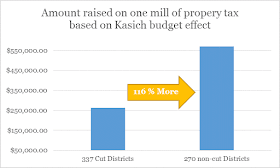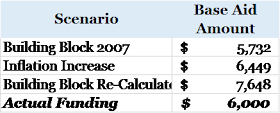Gov. John Kasich has been taking heat from
me and
others over his treatment of Ohio School Districts under his as introduced budget. What with 85 percent of Ohio's rural districts being cut, and now that the Ohio Legislative Service Commission has determined that Kasich's further reduction in reimbursement payments for lost Tangible Personal Property Taxes will mean that 388 of Ohio's 609 school districts will get less money in the 2018-2019 school year than they will this year, that criticism is warranted.
The Republican chair of the House finance committee called the plan "asinine."
So I'm not alone here.
Anyway, despite all this and Kasich's open admission that property taxes should fund more public education, in contravention to four Ohio Supreme Court
rulings, there is a slight, silver lining in his funding plan from an unlikely place: How it treats charter schools.
Yes, only 9 out of 370 charters will get less money in the 2018-2019 school year versus this year -- a paltry 2 percent cut rate compared with the nearly 65 percent of school districts that will see less money. But there are things to like about the direction of the charter funding.
Again, this is all relative to our atrocious history with charters. So take that caveat with you on this journey.
First of all, Kasich froze the base per pupil funding amount from this school year at $6,000 for each of the next two school years. So the automatic increase charters have traditionally received over the years from the steady increase of the per pupil funding amount won't happen this budget. And while I have reservations about this as a
policy long term, the fact is that for the first time since the 2010-2011 biennium, charters won't get automatic increases.
The increases charters
do receive are two-fold: money for facilities and money for performance. The facilities money is problematic because it comes out of state lottery money originally voted by Ohioans to go exclusively to school districts in order to relieve property tax burden. But it's not a ton of money.
Where I'm really encouraged is the money earmarked for performance. That slight increase, coupled with flat funding the elements that have historically bumped charter schools' funding, means that the largest increases for charters in this budget (generally) go to the highest performing charters in the state. So, for example, the Electronic Classroom of Tomorrow, the Ohio Virtual Academy, OHDELA, and the other horrifically performing
eSchools get zero additional dollars. Meanwhile, the high performing Cleveland charters and the Dayton Early College Academies get the largest increases.
That is a far cry from previous budgets this Governor has produced where the worst performing
charters got the largest dollar and percentage increases.
The problem of charter funding remains. Too often, local property taxpayers have to subsidize the vast majority of low performing charters that currently operate
here. And Ohio's House Bill 2 reform is maddeningly slow paced at producing the changes we need to see.
In addition, the largest dollar increase for performance (just under $50,000) wouldn't even cover the cost of an additional teacher.
But considering where we've been as a state on charters (namely, a national
laughingstock), this is most definitely progress. I look forward to having a robust discussion about reforming the mechanism for this state's charter school funding soon. But for the first time in our state's history, it appears we have a budget before us that provides more funding to the best performing charters in the state and does not reward the worst performers.
I suppose you can call this the slow slog of progress.
 State Sen Matt Huffman, R-Lima, introduced legislation recently to create statewide vouchers for any family who meets at least 400% of poverty (for a family of four, that's about $100,000, or roughly 81% of Ohio families).
State Sen Matt Huffman, R-Lima, introduced legislation recently to create statewide vouchers for any family who meets at least 400% of poverty (for a family of four, that's about $100,000, or roughly 81% of Ohio families).











